Section 22. Handoff Map
22. Handoff MapOverviewThe Handoff Map is one of the simplest tools available in a Lean Sigma project, but is powerful as both an analysis tool as well as a communication vehicle. The approach is to start with a circle representing the world of the process. Each function is then represented on the circle as a point on its circumference. The points should be equally spaced on the circle even if the actual physical locations aren't geographically equidistant, see Figure 7.22.1. Figure 7.22.1. An example of an As-Is Handoff Map for Desktop PC Acquisition.[40]
The process is then traced from the primary entity's perspective (often the simplest way is to trace the primary horizontal flow in the Value Stream Map to achieve this), and every time there is a change in functional owner, a line is placed inside the circle linking the from and the to. If there were a handoff within a function (such as a patient moved from one bed to another on a Care Unit), then a small loop would be drawn external to the circle (not shown in Figure 7.22.1) to represent this. Often a second (or even third) path is used on the map in a different color, representing a secondary entity such as information flow. For all the handoffs, the total number of types of handoffs and the total volume of handoffs in a given time period are calculated. Each and every handoff is an opportunity, or several opportunities, for failure; thus, the goal is to reduce the number of handoffs in the process. LogisticsConstruction of the Handoff Map is done by the Team and generally takes about an hour or so to create the pictorial element. The number of types of handoffs can be read straight from the map, but to determine the total volume of handoffs might require a data collection for a week or so unless historical data is available. RoadmapTwo versions of the Handoff Map are created at different points in a project, the first representing the Current State or "As-Is" and the second representing the Future State or "To-Be." Sometimes a third version is created if the To-Be map isn't implemented as originally thought. Construct As-Is
Construct To-BeThe To-Be could be built directly from a To-Be Value Stream Map in exactly the same steps as the As-Is Map, but there is opportunity to use the tool in a slightly more elegant way, using it to achieve some handoff reduction as follows:
Interpreting the OutputThe To-Be Handoff Map now graphically depicts any Global Process Cycle Time and Process Lead Time reduction opportunities. For more details see "TimeGlobal Process Cycle Time" and "TimeProcess Lead Time" in this chapter. Using the Handoff Map in conjunction with the Value Stream Map, document the findings and any opportunities for streamlining. |
EAN: 2147483647
Pages: 138
